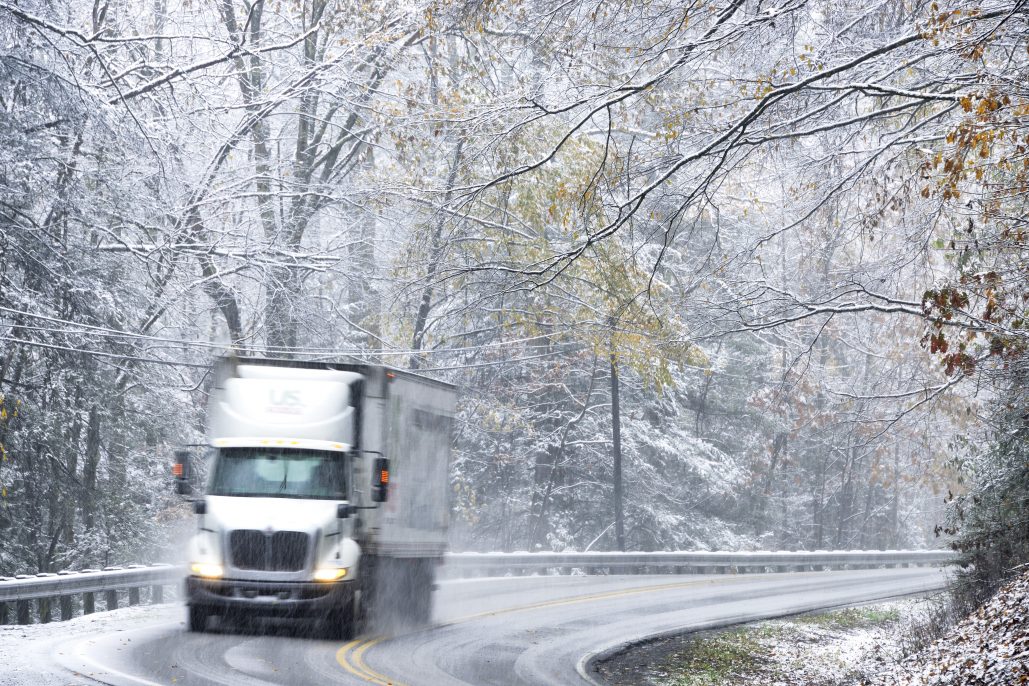
36 Must-Have Accessories for a Commercial Truck Driver
September 23, 2021
Survival Guide Long Haul Truckers | OTR Tips & Advice
December 9, 2021Recently updated on February 22nd, 2024
We truckers encounter some of the toughest driving conditions during the winter months, but with the right winter driving tips for truckers, you can arrive safely and on time. I drive trucks for a living, and I have seen dangerous weather on the road, from freezing rain to heavy snowfall to high wind to fog. Over the years, I have learned the best ways to drive a load in bad weather, and I want to pass on my top safe driving tips for truckers.
There’s good reason to worry about driving in bad weather. According to the Department of Transportation (DOT), around 21% of crashes are related to weather, and on average, each year, these crashes result in 5,000 deaths and injure approximately 418,000 people. Rain is the leading cause of these accidents, but winter conditions, such as falling snow or sleet, icy pavement, and snowy or slushy pavement, also cause many crashes.
When you are a professional driver and spend so many hours on the road, it’s even more important to worry about weather-related accidents. We all want to make good time, but no load is worth your life. With the right trucker safety tips, you can make good time and get there safely. As a seasoned veteran of the road, I have you covered with just a couple of essentials to make your winter a little smoother. Read on to get my top winter tips for truckers.
Trucker Tips for Driving in Snow
Inspect Your Vehicle
Your vehicle needs to stay in optimal condition to withstand the harsh conditions of winter driving. Inspecting your vehicle is a crucial part of preventing major problems out on the road. You can perform a thorough inspection yourself or even have a mechanic look over your truck to make sure it is ready to withstand extreme weather. Make sure your examination includes:
- Tire pressure check
- Engine oil check
- Antifreeze level check
- Brake light and taillight check
- Defroster and heat check
- Air tank check (make sure moisture has been drained)
- Mirror cleaning
- Wipers and wiper fluid check
Slow Down
Whenever you encounter dangerous road conditions, slowing down is one of the most important things you can do for your safety. Speed is a significant cause of or contributor to accidents. It’s even more important to watch your speed when encountering snow, sleet, ice, or rain. Slowing down gives you more control of the semi and gives you more time to react.
Give Yourself Some Extra Space
“I always drive with plenty of space in front of me so I’m not crowded,” replied Professional Driver Angel Vasquez from @el_ez_money when asked about his tips for navigating sloppy roads. Stopping on a wet road takes about twice the stopping distance of a dry one. Icy conditions on the road take about 10 times as much. It’s vital for your safety to account for this when you determine what counts as a safe distance between you and the other drivers. Other winter drivers may not be as careful as you, so it’s even more important to be cautious about your proximity to other vehicles.
Avoid Sudden Changes
When you are driving a semi in hazardous conditions, abrupt movements are not your friend. From jackknifing to skidding, many bad outcomes can result from suddenly applying the breaks or abruptly steering in a different direction.
Observe Tire Spray
Road conditions are not always immediately apparent. You need to look for certain signs to let you know what the road is like. Tire spray is an important indication that can tell you how wet the road is. If you see a lot of water spraying off the tires of other vehicles, you know the road is very wet.
More minimal tire spray can indicate that water has frozen on the road, and you need to drive cautiously. Other signs of poor road conditions include other drivers spinning out on the median or shoulder. If you start to see trucks spin out, it’s time to get off the road.
Use Your Headlights Effectively
You probably remember to turn on your headlights when you have poor visibility due to bad weather or at night. You also need to make sure that snow and ice are not covering your headlights, which can harm visibility. In addition to helping you see the road better, other drivers can spot you more easily.
Use Tire Chains
Before you set out on the road this winter, make sure your tire chains fit your tires and that you have practiced installing them. When the conditions warrant using your tire chains, pull over at a weigh station or rest area so that you have enough room to maneuver as you put on the chains.
Use Your CB
If you don’t have a CB radio, consider getting one. In addition to making you feel like you’re in Smokey and the Bandit, it can help you get information from other truck drivers about road conditions. Truckers can also help you by telling you where to pull over and install your tire chains. You can also look to weather updates on the news and speak to other truckers at truck stops.
Bring Adequate Supplies
Every time you haul a load in the wintertime, pack for the worst and hope for the best. You need to plan for emergencies. Pack your truck with extra blankets, food, water, cold-weather clothing, and a tool kit. Hands and feet are often the areas of the body that are most vulnerable to cold weather, so make sure you have gloves and boots that can withstand the cold. Keeping your cell phone charged is also helpful. These are good tips for trucker life in general, not just during the winter.
LubeZone loves truckers, and we want to help you be successful, especially during this time when truckers are more important than ever to the country’s supply chain. That’s why we provide tips to survive and thrive as a long-haul trucker. You can also count on us for all your preventive maintenance needs this winter season. Stop by one of our convenient locations to service your truck and get an oil change in 40 minutes or less because, at LubeZone, fast is back!



